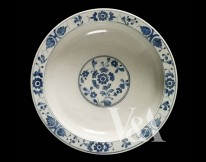5 Early European Porcelain

Chinese porcelain was technologically superior to almost all European ceramics made before about 1700. It was hard, dense, white and translucent, and early imports provoked debate about its exact nature and composition. Many immediately recognised it as a ceramic material, and potters across Europe attempted imitations. Most of these copies were made from red or buff earthenware covered with a white glaze and were only superficially similar to the Chinese originals.
However, in sixteenth century Italy, and then again in late seventeenth century France, much closer imitations were achieved. These featured both the white body and translucency that Europeans prized in Chinese pieces and were made from quartz and clay and a range of other materials. Known as ‘soft-paste’ porcelains, these were technically very different from the East Asian imports. Many porcelains of this type were made in eighteenth-century France, England and Italy.
Around 1710 a German alchemist discovered the nature of the raw materials and the firing processes followed by Chinese potters, which led to the foundation of the Meissen factory. Industrial spies took Meissen’s secrets of real or ‘hard-paste’ porcelain production to Venice and Vienna, from where they were spread across Germany. By 1800 they were common knowledge across the whole of Europe.



